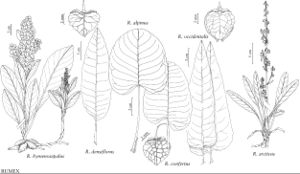Rumex hymenosepalus
in W. H. Emory, Rep. U.S. Mex. Bound. 2(1): 177. 1859.
Plants perennial, glabrous or indistinctly papillose-pubescent, with distinctly tuberous roots and short rhizomes. Stems usually erect, rarely ascending, branched above middle, 25–90(–100) cm. Leaves: ocrea prominent and persistent at maturity, whitish or silvery white, membranous; blade oblong, oblong-elliptic, or obovate-lanceolate, (5–)8–30 × 2–8(–12) cm, base cuneate or narrowly cuneate, margins entire, flat or indistinctly crisped, apex acute or acuminate, rarely obtuse. Inflorescences terminal, occupying distal 1/2 of stem, narrowly paniculate, rarely simple. Pedicels articulated near middle or in proximal 1/3, filiform, 5–15(–20) mm, articulation indistinct. Flowers 5–20 in whorls; inner tepals oblong-cordate or orbiculate-cordate, 11–16 × 9.5–14 mm, base sinuate or emarginate, margins entire, rarely with few extremely small denticles at base, apex obtuse or subacute; tubercles absent. Achenes brown or reddish brown, 4–5(–7) × 2.5–4.5(–5) mm. 2n = 40.
Phenology: Flowering spring.
Habitat: Sandy and rocky places: plains, slopes, stream beds, alkaline soils
Elevation: 0-1700(-2000) m
Distribution

Ariz., Calif., Colo., Mont., Nev., N.Mex., Okla., Tex., Utah, Wyo., Mexico (Baja California, Chihuahua).
Discussion
Rumex hymenosepalus is the only species of subsect. Hymenosepali Rechinger f.
Two varieties have been recognized. The typical variety has achenes 5 mm and ovate-elliptic or oblong-cordate inner tepals with a subacute apex. Variety salinus (A. Nelson) Rechinger f. has larger achenes (to 7 mm) and almost orbiculate inner tepals with an obtuse apex.
Rumex hymenosepalus was reported also from Montana (J. E. Dawson 1979), but no exact localities were given.
Selected References
None.
